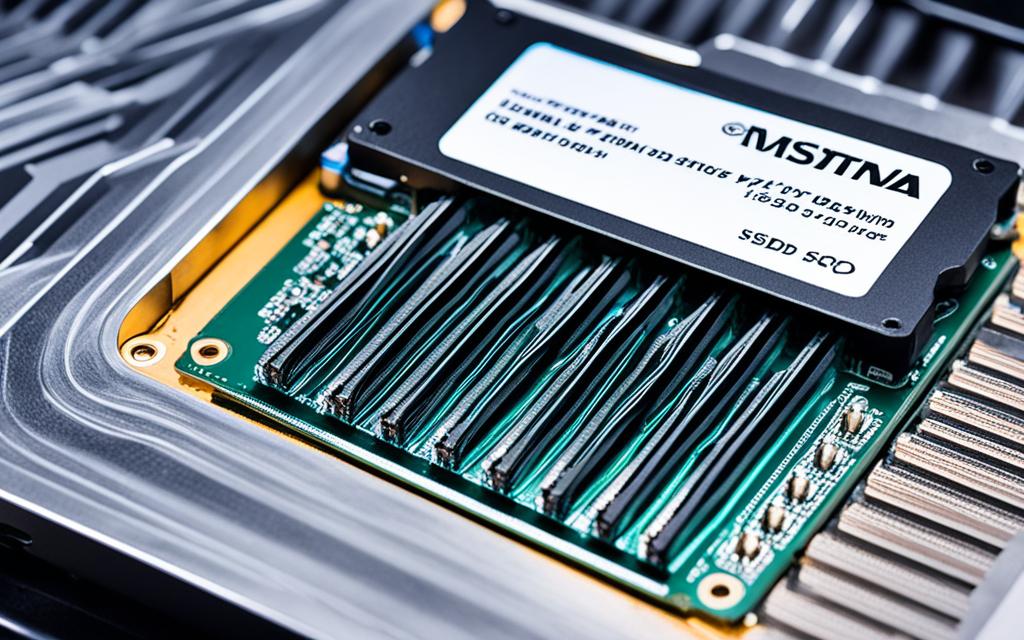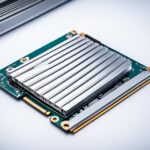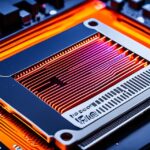Table of Contents
Exploring solid-state drives (SSDs), we see how vital heat sinks are. They keep drives cool as technology speeds up. Good SSD cooling solutions stop overheating. Thus, drives work well for longer.
SSDs, especially NVMe ones, need efficient heat management. With better performance comes more heat. Heat sinks move heat away from the SSD. This keeps temperatures low and prevents slowing down due to heat. This article will look at how heat sinks work on SSDs, what they’re made of, and how they boost SSD performance.
Key Takeaways
- Heat sinks are vital for maintaining optimal SSD performance.
- They prevent overheating during high-speed operations.
- Effective cooling solutions extend the lifespan of SSDs.
- Increased speeds in modern SSDs require improved heat dissipation.
- SSD heat sinks can significantly enhance gaming and application performance.
What Is a Heat Sink on SSD?
A heat sink is key for keeping solid-state drives (SSDs) working well. It helps us understand how it supports SSDs when they’re busy with a lot of data. Heat sinks remove extra heat from the SSD. This prevents it from getting too hot, which keeps it working smoothly and lasting longer.
Definition and Functionality
A heat sink is made to soak up and let out heat from an SSD when it’s being used. This is super important for NVMe SSDs. They can get hotter than 80°C when working hard. If they get too hot, they won’t work as well and could lose data. Keeping them cooler than 50°C makes them work better and last longer1.
Most new motherboards have a spot for cooling M.2 drives. But, if a heat sink doesn’t do its job well, the SSD might end up in a bad spot. For example, it could be put under the GPU where it’s harder for air to cool it down2 and3.
Materials Used in Heat Sinks
Heat sinks are usually made from aluminium or copper. That’s because these metals are really good at moving heat away quickly. This quick action helps keep SSDs cool even when they’re under a lot of stress. On top of that, clever designs with fins increase the area that can throw off heat. This ensures the SSD stays cool and works properly2.
| Material | Thermal Conductivity (W/mK) | Characteristics |
|---|---|---|
| Aluminium | 205 | Lightweight, cost-effective, good corrosion resistance |
| Copper | 401 | Superior thermal conductor, heavier, more expensive |
The Importance of Heat Dissipation for SSDs
SSDs are fast and efficient but they face a big challenge with heat. Knowing why SSDs get hot is key to keeping them running well and for a long time. Good heat management is important for these devices to work properly.
Why SSDs Generate Heat
SSDs heat up mainly because of their components working hard. When you play games or edit videos, SSDs can get really hot, really fast. A Gen4x4 SSD can reach 70 degrees Celsius in just 40 seconds without a heat sink. A Gen3x4 SSD takes three minutes to get that hot when it’s 25 degrees Celsius around4. If an SSD gets to about 80 degrees Celsius, it might slow down to avoid damage4.
Impact of Temperature on SSD Performance
Temperature greatly affects how well SSDs work. Going over 70 degrees Celsius, the SSD might slow down to stay cool4. NVMe SSDs can overheat easily if there’s not enough air moving around them5. This can cause your device to lag or stop responding during big file transfers.
Fans and special heatsinks can prevent this by keeping the SSD at a safe temperature. This helps the SSD work better and last longer5.
| SSD Type | Temperature Without Heat Sink | Time to 70°C | Cooling Solution |
|---|---|---|---|
| Gen3x4 SSD | 70°C | 3 minutes | Passive Coolers |
| Gen4x4 SSD | 70°C | 40 seconds | Active Cooling with Fans |
| Overall Limit | 80°C | – | – |
Do All SSDs Need a Heat Sink?
Managing heat is very important for SSDs. While SSDs without heatsinks work well for light use, the necessity of SSD heat sinks goes up for heavy-duty tasks. Knowing when you need a heat sink helps keep your SSD running well and lasting longer.
SSDs Without Heatsinks
Many SSDs work well without heatsinks, especially for simple tasks. Most basic models have good thermal management to stay cool under normal use. Yet, it’s important to check their heat handling capabilities by looking at their specifications.
When a Heat Sink Becomes Essential
As SSDs get faster and do more, heat sinks become important for top performance. For instance, PCIe 4.0 NVMe drives often need a heat sink to avoid slowing down when they’re busy. They’re especially needed for platforms like the PlayStation 5 during intense use6.
Newer PCIe Gen4 SSDs, like the CORSAIR MP600 PRO XT, need even more cooling7. Without it, SSD temperatures might reach 88°C during heavy tasks6. Using tools to watch these temperatures ensures SSDs stay safe7.
Benefits of Using Heatsinks with SSDs
Using heatsinks with SSDs improves performance and longevity. This is key as the need for speed and reliability grows. Both enthusiasts and professionals can gain from learning about SSD heatsinks.
Enhanced Performance
A heat sink keeps SSDs running smoothly by avoiding thermal throttling. This matters a lot when SSDs face intense tasks. It keeps data flowing quickly, without being slowed by heat. Without a good way to get rid of heat, SSDs can slow down a lot. This shows how crucial SSD heatsinks are8.
Tests by experts prove that SSDs with heatsinks perform at their best. This is vital for tasks that need lots of data and for gaming9.
Improved Longevity
Getting rid of heat well not only boosts performance but also makes SSDs last longer. It reduces the heat stress on inside parts10. This is important for tasks that use a lot of data for a long time. SSDs with heatsinks work better and more reliably in tough situations than those without.
| Feature | Standard SSD | SSD with Heatsink |
|---|---|---|
| Performance Consistency | Variable, prone to throttling | Stable, consistent |
| Temperature Control | Higher temperatures, risk of failure | Lower temperatures, reduced stress |
| Lifespan | Shorter due to heat issues | Extended with proper cooling |
| Cost | Lower initial cost | Higher investment, long-term savings |
Conclusion
It’s very important to know why SSD heatsinks matter if you want to make your SSD work better and last longer. Many fast SSDs get really hot. This can make them slow down or even break sooner. Studies show that SSDs without covers get too hot, which is bad for them11. So, using a good heatsink can stop these problems. This lets you enjoy your device more, whether you’re gaming or working.
As SSD technology gets better, cooling methods will also improve. This means we will see new designs and materials that work better. Copper is getting popular because it conducts heat very well12. Tests have shown that some aftermarket heatsinks, like the Sabrent M.2 2280 SSD Rocket Heatsink, are better than the usual ones. This shows it’s worth getting a good cooling system11.
To sum up, using the right cooling methods is key to making your SSD perform well. Especially when transferring big files or using an eGPU. People have found that additional cooling helps a lot in these situations13. By choosing good cooling solutions, you can get the most out of your SSD and make it last longer.
FAQ
What is the primary function of a heat sink on an SSD?
A heat sink on an SSD moves excess heat away. This keeps the SSD at the best temperature. It prevents slowing down and helps the SSD last longer.
Why do SSDs generate heat?
SSDs get hot because of the electric current in their parts. Tasks like gaming or video editing make them even hotter. Managing this heat is crucial.
Do all SSDs require a heat sink?
Not all SSDs need a heat sink. Some basic and older ones work fine without it. But for high-performance activities, a heat sink is vital to control heat.
What materials are commonly used for SSD heat sinks?
SSD heat sinks are mostly made from aluminium and copper. These metals are great at spreading heat. Some have fins to spread out the heat even better.
How does temperature affect SSD performance?
High temperatures can slow down an SSD. If it gets too hot, the SSD lowers its speed. This prevents it from getting damaged.
What are the benefits of using a heat sink with an SSD?
Using a heat sink prevents the SSD from getting too hot. This makes it work better and last longer. It keeps performance high, even with lots of use.
Is it important to have a heat sink for gaming SSDs?
For gaming SSDs, especially in consoles like the PlayStation 5, a heat sink is crucial. It stops them from overheating. This ensures games run smoothly without interruption.
Can SSDs operate without a dedicated heat sink in normal conditions?
Many SSDs don’t need a special heat sink for everyday tasks. They have their own ways to deal with heat. But a heat sink might be needed for heavy use.
Source Links
- https://www.minitool.com/lib/m2-heatsink.html – What Is M.2 Heatsink? Do NVMe SSDs Need Heatsinks? – MiniTool
- https://www.lexar.com/product/nm790-with-heatsink-m-2-2280-pcie-gen-4×4-nvme-ssd/ – NM790 with Heatsink M.2 2280 PCIe Gen 4×4 NVMe SSD
- https://www.easeus.com/computer-instruction/do-i-need-a-heatsink-for-my-m2-ssd.html – Do I Need a Heatsink for My M.2 SSD [2024 Full Guide]
- https://www.techtarget.com/searchstorage/post/Understand-SSD-overheating-and-what-to-do-about-it – Understand SSD overheating and what to do about it | TechTarget
- https://www.atpinc.com/de/about/stories/overcoming-nvme-thermal-throttling-temperature – NVMe SSD Thermal Management: What We Have Learned from Marathons
- https://forum.level1techs.com/t/are-nvme-heatsinks-worth-it-990-pro/202418 – Are NVMe Heatsinks Worth It? (990 Pro)
- https://www.corsair.com/us/en/explorer/diy-builder/storage/is-cooling-necessary-for-an-m2-nvme-ssd/ – Do you need to cool your M.2 NVMe SSD?
- https://www.techradar.com/news/ps5-ssd-heatsink-explained-what-is-it-for-and-do-you-really-need-one – PS5 SSD heatsink explained: what is it for and do you really need one?
- https://www.pcmag.com/picks/the-best-m2-solid-state-drives – The Best M.2 SSDs (Solid State Drives) for 2024
- https://community.tablotv.com/t/tablo-quad-runs-hot/18719?page=5 – Tablo Quad runs HOT!
- https://www.guru3d.com/review/guru3d-nvme-thermal-test/page-14/ – Guru3D NVMe Thermal Test – the heatsink vs. performance (Page 14)
- https://en.wikipedia.org/wiki/Heat_sink – Heat sink
- https://community.frame.work/t/are-ssd-heatsinks-worth-it-or-a-waste/27525 – Are SSD Heatsinks worth it or a waste?








